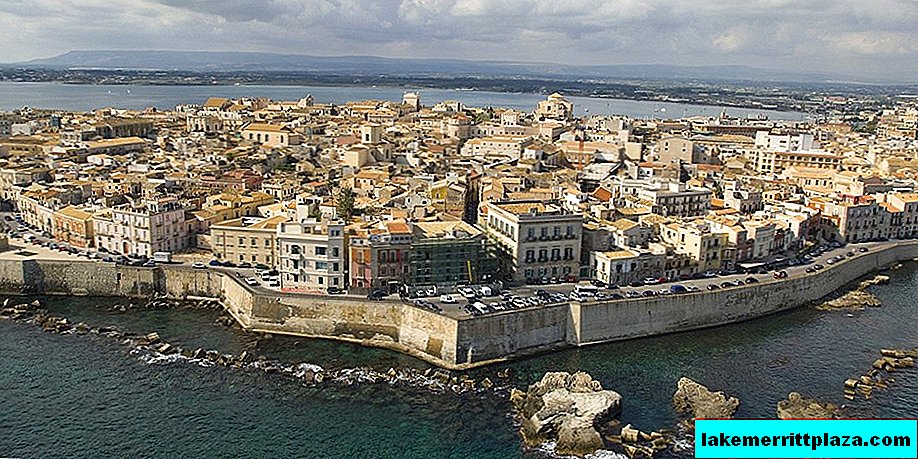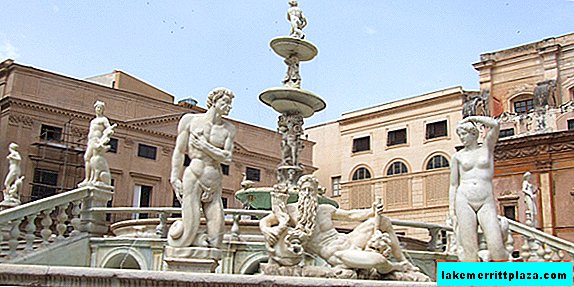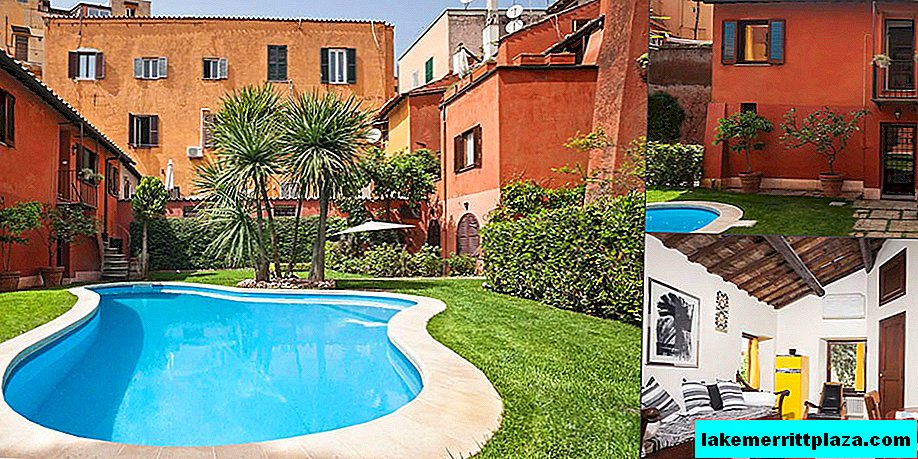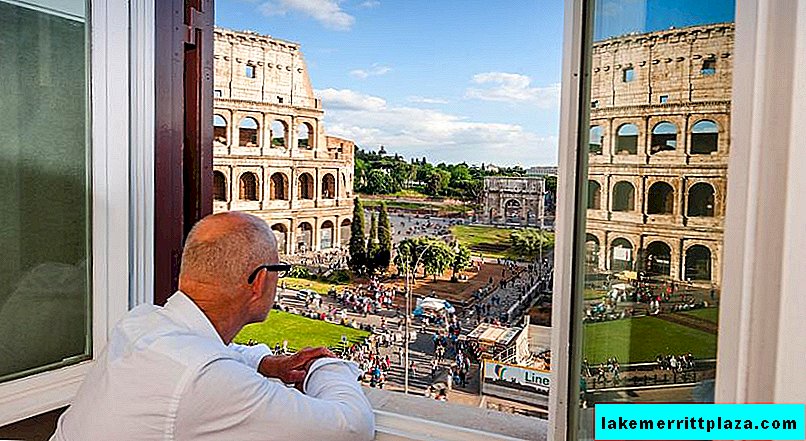What are the main attractions in Syracuse in Sicily?
Sicilian Syracuse (Siracusa) - a place as if materialized from ancient Greek myths and legends. A series of dizzying ups and devastating falls haunted this city in the pre-Christian era. No less disturbing was his fate in our era. And yet, Italians managed to turn Syracuse into a vibrant and colorful historical monument, preserve its sights, and also organize a great place for cultural tourism and beach holidays. Let's look into one of the most important cities of the island of Sicily, enjoy its views and plunge a little into the past.

In Syracuse, there are many buildings made by the ancient Greeks. The remains of majestic objects erected by the Greeks are considered World Heritage Sites. Gray stones cutting through bright greenery are protected by UNESCO. To join the history of the Ancient World and capture the main attractions - this is an extraordinary experience that guests of the city are eager to get.
- Read also: how to choose a hotel in Syracuse
Greek theater
Traveling 25 centuries into the past seems possible in the archaeological area of Syracuse - Neapolis. Its largest exhibit is the ruins of the Greek Theater (Teatro greco), built in the 5th century BC. The attraction experienced two reconstructions: in the Carthaginian and Roman periods. A huge amphitheater with a capacity of 15 thousand people was used as a place for cultural events and political meetings. During the rule of the Spaniards in Sicily, part of the stones of the ancient theater was commissioned to build a fort on the islet of Ortigia.

United Italy took the historical memorial under its care. On the territory of the Greek Theater, archaeological excavations were carried out. The stone structure was cleared and restored. Since the beginning of the 20th century, the National Institute of Ancient Drama of Italy has organized annual Greek art festivals on the stage of the theater. Watching Greek comedy or tragedy in an authentic Hellenic theater is one of the most memorable moments that can be remembered from Syracuse and even Italy itself.
Roman amphitheater

Another monument of ancient Syracuse is the Roman Amphitheater (Anfiteatro romano). It was built for general entertainment in the 1st century BC. The audience was invited to enjoy gladiatorial battles. This attraction was buried underground for a long time, while in the middle of the XIX century it was not brought to light by archaeologists. In its scale, the amphitheater in Syracuse is in third place after similar buildings in the Coliseum in Rome and the arena in Verona.
Ear of Dionysius

Near the Greek Theater, you can admire the grotto with the poetic name Orechio di Dionisio. Nature itself showed the wonders of architectural art, carving the entrance to this cave in the form of an auricle. However, the purpose of this grotto is far from romantic. In times of tyranny, there was a ruler Dionysus (IV century BC), who organized a dungeon in a cave. Dionysus tortured his captives and locked them in cells. The special internal structure of the cave allowed the insidious tyrant to eavesdrop on the conversations of the captives.
Hieron's Altar

Walking around Neapolis, you should take a look at the Altar of Hieron (Ara di Ierone II) built in the III century BC. He served the tyrant of Syracuse in order to sacrifice to the gods. On an impressive pedestal in size they laid dead bulls, several dozen, or even hundreds at a time!
Temple of Apollo

The Temple of Apollo (Tempio di Apollo), which is located on the island of Ortigia, looks contrasted against the background of modern buildings. Until the 19th century, the remains of the temple were hidden from the eyes of travelers. An archaeological group led by Paolo Orsi revealed to the world the ruins of an ancient temple, allegedly built in the 3rd century BC. The gray steps, partially preserved columns and part of the wall give some idea of how the building looked in its best years.
An inscription on one of the surviving stones of the temple allowed scientists to establish a patron whom the inhabitants of the island worshiped. It is also known that over time the temple managed to serve the Christian conquerors from Byzantium and the Muslim invaders of Sicily. Managed to make their contribution and the Normans.
Regional Museum of Archeology Paolo Orsi

By the way, in order to get a clear idea of the culture of peoples alternately dominating in Sicily, the Regional Museum of Archeology Paolo Orsi (Museo Archeologico Regionale Paolo Orsi) was opened in Syracuse. The archaeologist, under whose leadership most of the ancient memorials were rediscovered, collected many exhibits of ancient Greek, Carthaginian, Roman, Byzantine, Arabic, Norman, Spanish and other periods. The museum has been operating since 1878 and is very popular. Ticket price: 8 euros.
- Official website of the museum: www.regione.sicilia.it
Catacombs of St. John

The Catacombs of St. John (Catacombe Di San Giovanni), which appeared under Syracuse in Christian times (4th century AD), also deserve attention. Paolo Orsi devoted the last decade of the 19th century to a rigorous study of this object. Underground halls were used in the early Christian era to bury the influential people of the city. Ancient crypts are skillfully decorated with patterns and involuntarily fascinate visitors. Of greatest interest is the sarcophagus of the first bishop of Syracuse - Marciano (Marziano di Siracusa).

It is curious that the catacombs got their name thanks to the church, built by the Normans over the entrance to the dungeon. St. John the Theologian gave his name not only to the temple, but also to the previously nameless underground communications. Residents of Syracuse actively used caves in the period from IV to VI centuries. However, they are well preserved and served the population again during the Second World War. The catacombs of St. John shelter in their bowels alarmed Italians from the bombing.
Archimedes Square

In the historical part of the city you can stroll along the picturesque corso Matteotti street. The low buildings along the street greet travelers with bright facades. The true decoration of the old town is the small Archimedes Square (Piazza Archimede), dedicated to the famous resident of the city. In the center of the square there is a fountain decorated with a sculptural group led by Artemis the Hunter. The author of the sculptures is the architect Giulio Moschetti.
Cathedral

Another curious attraction of Syracuse is the cathedral of the city. On the site of the Duomo in the 5th century BC a temple dedicated to Athena was built. Thus, the tyrant Gelon immortalized his victory over Carthage. The construction, like the Temple of Apollo, went through a series of transformations. It was rebuilt by the Byzantines, then by the Normans.
Great damage fell on the temple during the earthquake in Sicily in 1693. During the restoration, the temple was rebuilt in the fashion of Sicilian baroque. To the honor of the builders, it is worth noting that several antique columns that survived from the ancient Greek period were organically integrated into medieval design. The surviving fragments of ancient architecture were moved by caring Italians to the Museum of Archeology Paolo Orsi.
Looking inside the cathedral, the visitor will be under a beautiful painted dome. The 17th-century frescoes, owned by Augustino Scilla and Luigi Vanvitelli, make a deep impression thanks to the color scheme and biblical subjects. The decoration of the cathedral uses a harmonious combination of light rust stone and gilded decor. We advise you to admire this attraction on your own!
Church of Santa Lucia alla Badia

The intricate top of the church of Santa Lucia alla Badia unwittingly attracts the attention of Syracuse guests. This building is inferior in size to the Duomo, but it surprises with its architecture. The church, nestled on the edge of Cathedral Square, bears the name of the patron saint of the city. There is a whole legend regarding the person of Saint Lucia.
Legend of Saint Lucia
Once upon a time, a beautiful girl named Lucia lived in Syracuse. She was pious and decided to devote herself to the church. The vow of celibacy upset the girl’s parents and the man to whom she was promised. The treacherous groom decided to take revenge on his beloved. He demanded that Lucia, who turned away from him, be sent to a brothel. However, the girl’s faith was so strong that not a single soldier or any other person could move the pious from her place.
The fate of the girl was sad, she was cruelly tortured, but could not be persuaded to renounce this vow. After her death, Lucia became a holy martyr and patroness of her native city. Within the walls of the church you can see the canvas of the work of Caravaggio "Burial of Saint Lucia."
Arethusa Spring

Via Picherali is ideal for continuing your walk in Syracuse. This street will lead travelers to the picturesque promenade. You can completely surrender to the sound of the waves and the whisper of the wind, incorporating all the charms of the sea panorama. Or turn your attention to the spring of Aretusa (Fontana Aretusa).
According to the legends of the ancient Greeks, Arethusa is a beautiful river nymph who tried to hide from the god Alpheus. The mighty Artemis helped the girl by turning her into a stream. Seeing this, Alpheus turned into a sea. He stayed next to his beloved, weaving the gentle waters of a stream with powerful sea currents.
Church of the Weeping Madonna

The most modern landmark of the city is the Church of the Crying Madonna (Madonna delle Lacrime). In 1953, an amazing event occurred in the house of ordinary residents of Syracuse - the image of the holy Madonna burst into tears. For some time, the tear-pouring icon was a local curiosity until the news of it reached the Vatican. For some time, the holy fathers decided whether such a miracle was worth high confidence. Finally, in the 70s of the XX century, the weeping Madonna was recognized as a miracle. In her honor, it was decided to build a church.
The Church of the Weeping Madonna was completed in 1994. The building is striking in its amazing architecture; it does not look like any classical Catholic church. Looking at it from a bird's eye view, you can see a silver star. And if you admire the building from the ground, then you can see the ribbed cone, crowned with a golden statue of the Madonna.
Surprisingly, the church is made of wood, and its height is 75 meters.
There are simply no similar buildings in Syracuse, so the church’s spire can be seen anywhere in the city. The interior of the church is also famous for originality and beauty. The Church of the Weeping Madonna has three thematic exhibitions: an exposition dedicated to the wonderful tear face, a museum of the offerings to the Holy Madonna and an exhibition of festive clothes for the priests of the church.
Palaces
Vermexio Palace

Just a 10-minute walk from Cathedral Square is one of the palaces of Syracuse. Vermexio Palace (Palazzo del Vermexio) also known as the Senate Palace was built in 1633 for the needs of city authorities. The architect of this mansion was Giovanni Vermexio. In the appearance of the palace, the creator’s tendency towards strict geometric shapes and clear lines is clearly felt. The main part of the building is a precisely calibrated cube, to the side faces of which two additional wings were later attached.
Two architectural styles contrast in the exterior decoration of the palace. The first tier of the building was made in the Renaissance style, and the second tends to be luxurious baroque. A balcony with elegant wrought iron railings stretches along the second floor of the Vermexio Palace. The windows and door to the balcony are equipped with sculptural decorations. The rich decoration of the upper part of the building deserves special attention. By the way, the architect, nicknamed the "lizard" for his thinness, marked the palace building with this playful symbol.
Vermexio's perfectionism in relation to the proportions of the building was trampled by the superstructured attic tier. And in the XX century, the growing needs of the city municipality required the extension of two rectangular wings to the cube of the palace.
Montalto Palace

The island of Ortigia serves as the location of another attraction - Palazzo Montalto. This building was built at the expense of the noble Sicilian Machota Mergulese at the end of the XIV century. In the days of the Kingdom of Aragon, the palace passed into the hands of Filippo Montalto, from where its modern name came from. In the XIX century, the palace was given to the needs of doctors and nurses who were fighting the cholera epidemic. Subsequently, he turned into the residence of the Order of the Daughters of Mercy.
The exterior of the Montalto Palace is strongly influenced by Gothic architecture as well as the Palermo school of architecture. Near the building there is an archaeological site. Perhaps in the future old secrets will be revealed, carefully preserved by the island.
Moniace Palace

Moniace Palace (Castello Maniace) is the most monumental and visible building of Syracuse. It is located in the southernmost part of the island of Ortigia and the date of its foundation is considered to be 1240. The castle owes its name to the Byzantine commander Maniak (Moniace), who managed to wrest Sicily from the clutches of Arab invaders in the 11th century. The palace appeared during the Sicilian kingdom thanks to the patronage of Emperor Frederick II.
According to some reports, the construction of the palace was supervised by the architect Riccardo da Lentini. He made every effort to ensure that the castle meets the needs of the most influential persons of the state. For a long time, the residence of the emperor of Sicily was in the Palace of Moniache, then the monarchs of the kingdom of Aragon chose this castle. And in the middle of the XVI century the secular life of the palace ended, it was reoriented to military needs. Fortifications, tightly joined the palace building, forming a powerful defensive complex on the southern tip of the island of Ortigia.
In the XVIII century, ammunition was saved in the premises of the Moniace castle, which led to an accident. The detonated charges caused considerable damage to the palace. For a short period of time, the affected castle was at rest until the Emperor Napoleon turned his eyes to it. For a long time, the fortress performed its combat function, and the palace building served as barracks for artillery regiments.
It was possible to return secular gloss to the Moniace castle in the 20th century. The formidable and impregnable fortress was restored and began to receive visitors as a tourist attraction of Syracuse.









